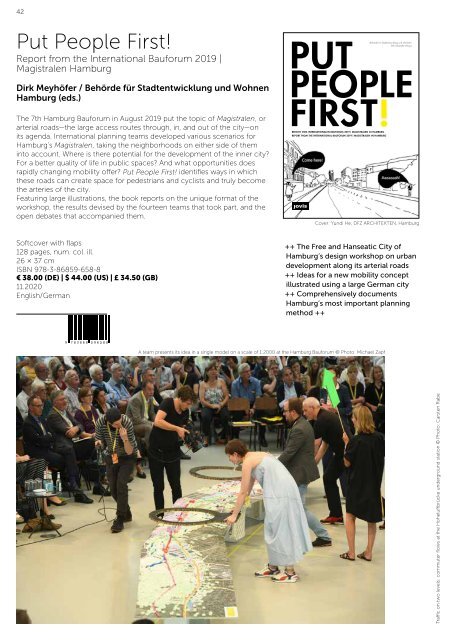JOVIS Catalog Spring 2021
Create successful ePaper yourself
Turn your PDF publications into a flip-book with our unique Google optimized e-Paper software.
BSW_2010_Umschlag_RZ.indd 8-11<br />
42<br />
Put People First!<br />
WIE SIEHT DIE MAGISTRALE DES 21. JAHRHUNDERTS AUS?<br />
WHAT DOES THE MAGISTRALE OF THE 21ST CENTURY LOOK LIKE?<br />
Report from the International Bauforum 2019 |<br />
Magistralen Hamburg<br />
Ein Boulevard! (Michael Kaschke, WES LandschaftsArchitekur, D)<br />
… Nothing to do with cars! (Bart Brands & Darius Reznek,<br />
Dirk Karres Meyhöfer en Brands, NL) / Behörde für Stadtentwicklung und Wohnen<br />
Hamburg (eds.)<br />
Prachtstraße für Stadtleben und Stadtströme! (Han van de Wetering,<br />
Van de Wetering Atelier für Städtebau, CH)<br />
The Grün, 7th langsam, Hamburg zauberhaft, gemeinschaftlich Bauforum und gemischt in August 2019 put the topic of Magistralen, or<br />
(Prof. Anne-Julchen Bernhardt, BeL Sozietät für Architektur, D)<br />
arterial roads—the large access routes through, in, and out of the city—on<br />
Hamburg’s Magistralen, taking the neighborhoods on either side of them<br />
6 Tage, 14 gemischte Teams, 8000 Besucher: Hamburgs Magistralen, die großen Ein- und Ausfallstraßen der<br />
Stadt, waren Thema des Internationalen Bauforums im August 2019. In intensiver Tag- und Nachtarbeit haben<br />
its agenda. Resilient, multifunctional, International courageous, profound, candid planning teams developed die Teams Drehbücher für diese 8 various bis 20 Kilometer langen Räume scenarios entwickelt und die Quartiere for rechts und links<br />
(Agata Woźniczka, BUDCUD, PL)<br />
der Magistralen in den Blick genommen. Wo liegt hier das Potenzial für Innenentwicklung und mehr Lebensqualität<br />
im öffentlichen Raum? Können diese Magistralen zu den Schlagadern einer Stadt umgebaut werden, in<br />
der die Perspektiven der Fußgängerinnen und Fußgänger und der Radfahrerinnen und Radfahrer das Maß aller<br />
Dinge sind – Put People First?<br />
into<br />
Vibrant,<br />
account.<br />
pedestrian-friendly,<br />
Where<br />
“glocal”, everchanging-diverse,<br />
is there potential for the development of the inner city?<br />
local-ownership (Jonas Nordgren, Schauman & Nordgren Architects, DK)<br />
Das Buch berichtet in großen Bildern über ein außergewöhnliches Werkstattformat, die Ergebnisse der Teams<br />
For a better quality of life in public spaces? und die And öffentliche Debatte, what die in dieser opportunities Woche in Hamburg geführt wurde. does<br />
rapidly changing mobility offer? Put People First! identifies ways in which<br />
6 days, 14 mixed teams, 8000 visitors: Hamburg’s Magistralen, the city’s arterial corridors, were the theme of<br />
the International Bauforum in August 2019. Working intensively day and night, the teams developed scripts for<br />
these routes, ranging in length from 8 to 20 kilometres, turned the spotlight on the neighbourhoods on either<br />
these roads can create space for pedestrians and cyclists and truly become<br />
side of them. Where could potential be found for interior development and for a better quality of life in public<br />
areas? Can these Magistralen be reshaped to become arteries of a city where the perspectives of pedestrians<br />
the arteries of the city.<br />
and cyclists are the norm – in order to Put People First?<br />
This book gives the big picture, revealing an extraordinary workshop format, the results produced by teams,<br />
Featuring large illustrations, the book reports on the unique of the<br />
and the public debate that took place in Hamburg during that week.<br />
workshop, the results devised by the fourteen teams that took part, and the<br />
open debates that accompanied them.<br />
PUT PEOPLE FIRST! Behörde für Stadtentwicklung und Wohnen, Dirk Meyhöfer (Hrsg.)<br />
PUT<br />
PEOPLE<br />
FIRST!<br />
BERICHT VOM INTERNATIONALEN BAUFORUM 2019 | MAGISTRALEN IN HAMBURG<br />
REPORT FROM THE INTERNATIONAL BAUFORUM 2019 | MAGISTRALEN IN HAMBURG<br />
Behörde für Stadtentwicklung und Wohnen<br />
Dirk Meyhöfer (Hrsg.)<br />
Cover: Yundi He, DFZ ARCHITEKTEN, Hamburg<br />
WIE SIEHT DIE MAG<br />
WHAT DOES THE M<br />
Die Magistrale des 2<br />
Städtebau der klassis<br />
funktio nale Ansprüch<br />
Beitrag leisten zur kli<br />
(Prof. Günther Vogt, V<br />
The good, the evil, th<br />
the separator, the sta<br />
Vernetzt, polyzentral,<br />
(Prof. Klaus Overmeye<br />
Point of orientation, C<br />
Scenic route, Green l<br />
A rainbow with para<br />
(Prof. Kees Christiaans<br />
Grün, blau, lebendig<br />
MAN MADE LAND,<br />
Bike-friendly, Multifun<br />
Low-speed-vehicles, H<br />
Softcover with flaps<br />
128 pages, num. col. ill.<br />
26 × 37 cm<br />
ISBN 978-3-86859-658-8<br />
€ 38.00 (DE) | $ 44.00 (US) | £ 34.50 (GB)<br />
11.2020<br />
English/German<br />
++ The Free and Hanseatic City of<br />
Hamburg‘s design workshop on urban<br />
development along its arterial roads<br />
++ Ideas for a new mobility concept<br />
illustrated using a large German city<br />
++ Comprehensively documents<br />
Hamburg’s most important planning<br />
method ++<br />
A team presents its idea in a single model on a scale of 1:2000 at the Hamburg Bauforum © Photo: Michael Zapf<br />
Traffic on two levels: commuter flows at the Hoheluftbrücke underground station © Photo: Carsten Rabe


















